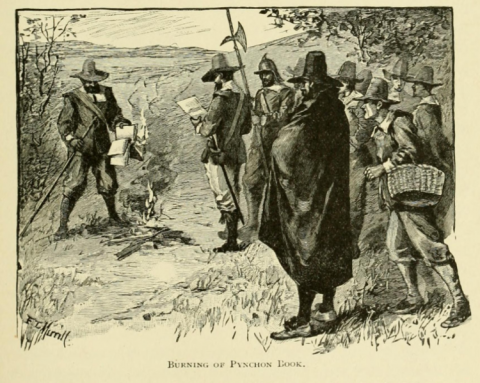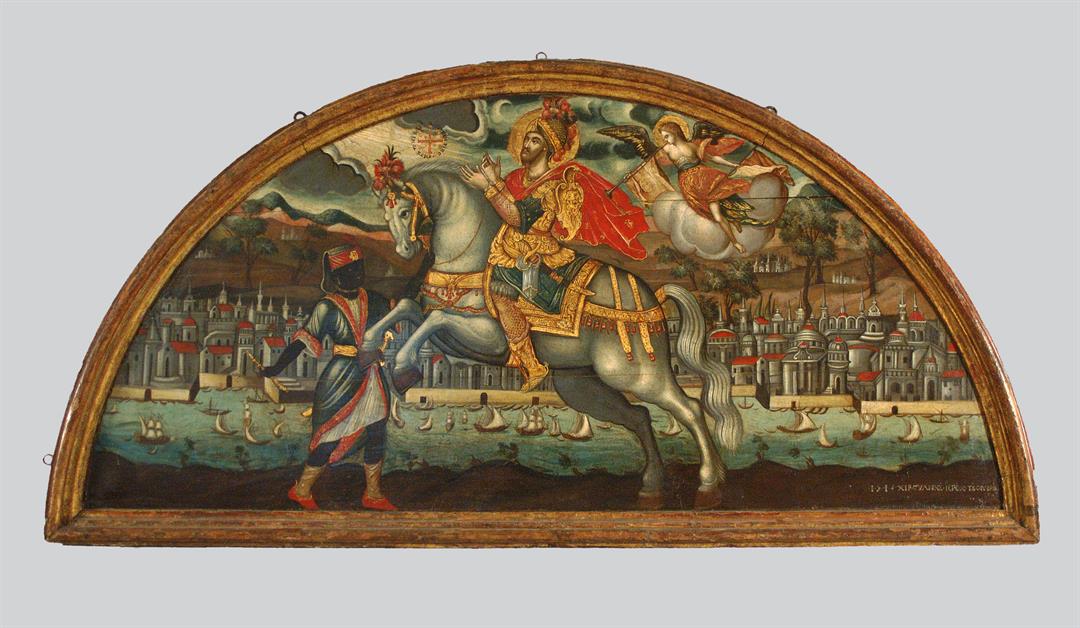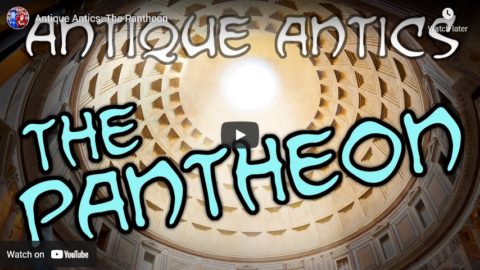… we don’t know exactly who founded the Library and we aren’t clear on precisely when. What is clear is that it was quite early in the history of what was to become the great city of Alexandria and that its establishment made the city a centre of learning for centuries to come. What should also be made clear, however, is that it was not actually a “library” that was established at all. The “Great Library” that we refer to was a collection of books associated with a religious shrine – the Musaeum or Mouseion. This institution was, as the name implies, dedicated to the Nine Muses: Clio (history), Urania (astronomy), Calliope (epic poetry and song), Euterpe (lyric song), Polyhymnia (sacred song), Erato (erotic song), Melpomene (tragedy), Thalia (comedy) and Terpsichore (dance). The temple to the Muses had a dedicated priest appointed by the Ptolemaic kings and was the centre of a complex that included an exhedra, or hall, with recesses and seats for lectures and private study. According to the only and rather brief surviving description, given by Strabo in the early first century AD, it also included a communal dining hall with kitchens, a dormitory and other residential apartments, extensive gardens decorated with statues and a shaded walk. What we call the “Great Library” was a collection of books gathered to service the scholars who were housed and worked in the Mouseion and it was stored partially in the complex itself and, later, on other sites including at least three “daughter libraries”. The popular image of the Great Library as an echoing hall lined with shelves of scrolls with desks and tables for scholars is almost certainly inaccurate. That kind of library, which is still the model for many traditionally-styled libraries today, was developed much later by the Romans and the Mouseion would instead have had “a colonnade with a line-up of rooms behind … the rooms would serve for shelving the holdings and the colonnade provide space for the readers.” (Lionel Casson, Libraries of the Ancient World, Yale University Press, 2001, p. 34)
The Mouseion at Alexandria was far from the only shrine to the Muses in the ancient world, nor was it the only one with an associated centre of study. Pythogoras had recommended the establishment of a shrine to the Muses for the promotion of learning on his first arrival on Croton, for example and the Seleucid kings built one at Antioch in the late second century BC, with an attendant centre for study and a library. The fact that the Great Library was actually associated with a religious shrine is something that is ignored or glossed over in many modern accounts. [Carl] Sagan […] mentions about how one of the “daughter libraries” was the Serapeum, which was the temple of Serapis, but he skips around this in a rather gingerly manner. He says the Serapeum was “once a temple, but was later reconsecrated to knowledge”. This is nonsense. The Serapeum was always a temple and was not “reconsecrated” to anything. Libraries were often established as adjuncts to temples but it seems Sagan was attempting to distance the “annex” of the Great Library from the temple in which it sat because this did not quite fit his theme of secular knowledge’s superiority to “mysticism”. Like the Serapeum, the Mouseion was a temple with a research institution and a book collection associated with it.
This aside, the Mouseion really was primarily a research institution and its associated book collection – which we will continue to refer to by the shorthand expression the “Great Library” – was clearly one of if not the most extensive in the ancient world (more on that below). Many famous ancient scholars worked in the Mouseion, including Eratosthenes and probably Ptolemy. But several who are often claimed as working there (or even as being “librarians” of the Great Library, no less) clearly did not. Sagan’s hymn of praise says that Hipparchus studied there, but he seems to have only used some of the books from the collection and there is no evidence he ever even visited from his home on Rhodes. Likewise Sagan says Archimedes worked there, but there is no clear evidence for this and what little we know of Archimedes’ life indicates he spent it in Syracuse. Of the others Sagan mentions, Euclid and Herophilos may have studied there, depending on when the Mouseion was established and Dionysius of Thrace is another maybe, though more likely. On the whole, Sagan’s roll call of great scholars is mainly hyperbole and speculation rather than historical fact. The other figure who is regularly invoked as being associated with the Great Library, and even presented as its “last librarian”, is (again) Hypatia. This is despite the fact that both the Great Library and its daughter library in the Serapeum had ceased to exist by her time.
Tim O’Neill, “The Great Myths 5: The Destruction Of The Great Library Of Alexandria”, History for Atheists, 2017-07-02.
March 1, 2022
QotD: The Great Library of Alexandria
February 25, 2022
QotD: The lure of the forbidden knowledge
When we as academics avoid those uncomfortable questions, we unwittingly invite others to answer them for us. When activists try to suppress rather than debate speech they find loathsome, they should know they are adding to its mystique.
Forbidden ideas have an appeal that orthodoxy never does — just ask Martin Luther. In fact, the parallels between the rise of the alt-right and the Reformation are interesting. In Luther’s world the printing press had recently created new and difficult to control ways for people to share subversive ideas. Early forms of capitalism led to the rise of new social classes and fueled resentment against traditional elites and traditional forms of authority. There were even early forms of the meme. Long before Pepe the Frog was co-opted by the alt-right, drawing donkey ears on images of priests was a way of provoking the powerful.
It’s surely the case that some of the speech that activists and university administrators seek to suppress poses a much more direct threat to real people than does a debate about supply side economics or evolution, but it’s worth remembering that to the Church, the Lutheran heresy was a real threat too. It posed a mortal danger to the eternal souls of people who were deceived by its falsehoods and rejected orthodoxy. I doubt that the Inquisitors felt any more qualms about deplatforming Lutheran heretics than did the activists at Middlebury.
As the Church learned, simply suppressing heresy cannot guarantee that it will go away. If anything, meeting heretical speech with violence or disruption just adds to its allure, confirming in the minds of the already convinced that they are right and leading the fence sitters to take another, perhaps more sympathetic, look. Dismissing heretical speech because it falls into a category that is rejected by the orthodox is not that much more effective a strategy.
We can do a lot to keep things from getting to the sort of highly contentious encounters like the ones at Middlebury and Berkeley, just by addressing uncomfortable issues with evidence rather than just categorization in our courses. Next time you are tempted to sidestep contentious issues in your class or to dismiss a student’s question because it falls into a forbidden category, don’t.
In the long run we can’t win an argument by avoiding it.
Erik Gilbert, “Liberal Orthodoxy and the New Heresy”, Quillette, 2019-02-04.
February 7, 2022
History Summarized: Vikings
Overly Sarcastic Productions
Published 14 Jul 2017Huge thanks to our friend Shad at Shadiversity! Check out his channel for historical weaponry and much more: https://www.youtube.com/user/shadmbrooks
Grab your swords and hop in your longboats, because it’s time to learn a thing or two about the Vikings!
This video was produced with assistance from the Boston University Undergraduate Research Opportunities Program.
Thanks to patron Karl Erik L Hoftaniska for suggesting this topic!
PATREON: www.patreon.com/user?u=4664797
MERCH LINKS:
Shirts – https://overlysarcasticproducts.threa…
All the other stuff – http://www.cafepress.com/OverlySarcas…Find us on Twitter @OSPYouTube!
From the comments:
Finn Chitwood
4 years ago
In the words of a brilliant Icelandic magazine: “Viking was a seasonal, temporary occupation, not an ethnicity.”
January 26, 2022
Three generations of the OG Puritans
At Founding Questions, Severian considers the New England Puritans and the world they inhabited:

Portrayal of the burning of copies of William Pynchon’s book The Meritous Price of Our Redemption by early colonists of the Massachusetts Bay Colony, who saw his book as heresy; it was the first-ever banned book in the New World and only 4 original copies are known to survive today.
Engraving by F.T. Merrill in The History of Springfield for the Young by Charles Barrows, 1921.
Total cultural and intellectual uniformity, constantly reinforced. If those Puritans were going to go crazy, in other words, they’d do it within very carefully circumscribed boundaries. The only thing close to that level of mental control is Twitter … and I suppose I must put the disclaimer out front, so that you can factor it in if you disagree with me: I hate the Puritans. They’re just SJWs with balls and a slightly less tedious prose style. When they’re not obsessing over the tiniest motions of their pwecious widdle selves, they’re screwing you over for the hellbound heathen you are.
Credit where it’s due, though: If you need to go sodbusting in an unexplored continent, the Puritans are your guys. The original Plymouth Bay colony was thoroughly militarized, and they didn’t fuck around — when the local Indian tribes were beginning to wonder if they shouldn’t do something about these White devils they’d let loose, the Puritans attacked the fiercest tribe and wiped them out, as a show of force. Life was hard in the OG Plymouth Colony, but it was about as good as you were going to get in that era.
But the typical inheritance pattern soon took over. “Regression to the mean” is a behavioral phenomenon, too, not just an IQ one. Puritanism is an obsessive, paranoid creed; it can only flourish in times of high stress and dire insecurity. But by the 1690s, Plymouth Colony was arguably the healthiest, wealthiest, safest place per capita in Christendom (not a high bar, obviously, but still). The OG settlers were all gone by that time, of course — the original settlement, you’ll recall, was 1620 — and so were most of their almost as hardcore kids. The third generation was coming up fast …
… but finding their way blocked by the old men of the previous generation, who were as tediously, dogmatically Puritan as the OGs, but without the stones. This made them — the 2nd generation — enormous hypocrites, but even without the hypocrisy, imagine living in a world where the ultra-wealthy who control everything in society tell you that they deserve it all, because they’re God’s Elect, while you, sinner, deserve to live in a rented box and eat bugs and own nothing, because God hates you.
History’s full of weird stuff like that, and that was the situation circa 1690. One example will have to do: Since we probably all got to experience Nathaniel Hawthorne’s existential angst back in high school, consider that the ancestor who caused him so much grief, Judge John Hathorne, was born in 1641. He would’ve been 51, then, during his trial service – a ripe old age by 17th century standards.
Not only that, but the 2nd generation — the one that stubbornly refused to move on and let the kids take their place in the sun — had spent the previous twenty years grievously fucking things up. King Philip’s War nearly ruined the colony, there’d been widespread plague, and oh yeah, that whole Restoration thing back in England — the hardest of hardcore Puritan thinkers in the run-up to the Civil War had been colonials; guys like Col. Rainsborough were closely associated with Massachusetts, etc. Lots of bad blood on the other side of the water, and while the third generation was willing to let bygones by bygones, the 2nd generation wasn’t.
So: Hypocritical old throwbacks and cavemen, with a decades-long track record of dumbfuckery, who just wouldn’t get out of the way. As they got older, they got more insular and inward-looking, as old people tend to do … and “more inward looking” for a Puritan is a near-BCG level of narcissism. Meanwhile, the new generation is eager to take their place in the burgeoning Atlantic world, especially after the Glorious Revolution (1688) … but can’t.
January 20, 2022
“McLuhan came to be regarded by the Baby Boomer generation as a guru and prophet; a visionary who had discovered something profound, not merely about the media, but about life and the universe”
In Quillette, Graham Majin looks at the life and works of Marshall McLuhan:

Marshall McLuhan, 1945.
Library and Archives Canada reference number PA-172791 via Wikimedia Commons.
The media ecosystem of the early 21st century is marked by a collapse of trust in journalism. How did we get here? As we look back, like a detective searching for clues, one moment stands out as significant; the publication on March 1st, 1962, of The Gutenberg Galaxy, written by a then-obscure Canadian academic named Marshall McLuhan. This book set in motion a line of falling dominoes, the consequences of which continue to affect us profoundly today.
McLuhan came to be regarded by the Baby Boomer generation as a guru and prophet; a visionary who had discovered something profound, not merely about the media, but about life and the universe. During the 1960s, he became a major celebrity, especially in the US. He featured on the cover of Newsweek magazine, was frequently interviewed on TV, and made a cameo appearance in Woody Allen’s 1977 movie Annie Hall. There was even a prog rock band named in his honor. The American media historian Aniko Bodroghkozy writes that “no other figure who was not of the movement itself received so much positive notice in the alternative newspapers that served dissident youth communities.” In 1965, the celebrity journalist Tom Wolfe asked breathlessly, “Suppose he is what he sounds like, the most important thinker since Newton, Darwin, Freud, Einstein, Pavlov?” Wolfe described McLuhan as an almost Christ-like figure:
A lot of McLuhanites have started speaking of him as a prophet. It is only partly his visions of the future. It is more his extraordinary attitude, his demeanor, his qualities of monomania, of mission. He doesn’t debate other scholars, much less TV executives. He is not competing for status; he is alone on a vast unseen terrain, the walker through walls, the X-ray eye.
Writing in 1967, John Quirk agreed that McLuhan was a “savant and prophet” and explained that, “McLuhanites hold that the new technologies will lend men the awareness and instruments necessary to solve contemporary problems and inaugurate a bright new era.” McLuhan was a master of the catchy one-liner and the original source of Timothy Leary’s famous counterculture catchphrase, “Turn on, tune in, drop out.”
McLuhan’s division of media into two types was certainly influential although that influence wasn’t particularly useful:
In The Gutenberg Galaxy, McLuhan observed that the decline of Catholicism, the rise of Protestantism, and the drift towards secularism all coincided with the development of printing. He hypothesized that the invention of printing had produced the European Enlightenment and Victorian liberal democracy. It was not what was printed, but printing itself that was responsible. McLuhan classified all media into two types: “hot” and “cool”. Printed books and newspapers, he suggested, were “hot” because they were bursting with information. Pre-Renaissance forms of communication, on the other hand, like the spoken Catholic Mass, were “cool”. This was because the Mass was spoken in Latin and hence contained little or no information that ordinary people could understand. Handwritten books were also categorized as “cool”.
Baby Boomers were quite receptive to McLuhan’s message, as it told them very much the sort of thing they wanted to hear:
He had produced a Boomer-friendly, sanitized version of his thesis in which magic and fantasy replaced religion. He also took care to flatter his Boomer audience by telling them that they were uniquely in tune with a deeper reality their parents could not see or understand. “We of the TV age,” he wrote, “are cool. The waltz was a hot, fast mechanical dance suited to the industrial time in its moods of pomp and circumstance. In contrast, the Twist is a cool, involved and chatty form of improvised gesture.”
McLuhan told the Boomers that they might appear irrational to their parents, but this was simply because the old generation was raised on obsolete “hot” media. As a result, he said, they had lost touch with their emotional side and become unnaturally rational and impartial: “Phonetic culture endows men with the means of repressing their feelings and emotions when engaged in action. To act without reacting, without involvement, is the peculiar advantage of Western literate man.”
McLuhan was a key influence on the Boomers, but his ideas failed when logically analyzed:
Trying to deconstruct McLuhan’s arguments reveals glaring absurdities. For example, it is self-defeating to claim that the content of a message is unimportant. On the contrary, all messages must convey information which corresponds with, or claims to correspond with, some state of affairs in the real world if they are to be useful. A news article without news, a weather forecast that does not mention the weather, or a traffic report lacking information about traffic might all be deliciously McLuhanesque, but they are not helpful. Even the Bible, revered by McLuhan, would be meaningless if it were merely a book of random words and blank pages. As Finklestein summarized, McLuhan’s argument is “absurd, when analyzed.”
McLuhan might well be the patron saint of fake news.
January 8, 2022
Antique Antics: The Pantheon
Overly Sarcastic Productions
Published 7 Jan 2022It’s a good dome, simple as that.
SOURCES & Further Reading: The Great Courses lectures: “The Most Celebrated Edifice – The Pantheon” from Understanding Greek and Roman Technology by Stephen Ressler, and “Roman Art and Architecture” from The Roman Empire: From Augustus to The Fall of Rome by Gregory Aldrete. “The Pantheon” by Chris Legare via ATouchOfRome https://www.atouchofrome.com/the_pant…. Additionally, I have a university degree in Classical Studies.
Our content is intended for teenage audiences and up.
PATREON: https://www.Patreon.com/OSP
PODCAST: https://overlysarcasticpodcast.transi…
DISCORD: https://discord.gg/osp
MERCH LINKS: http://rdbl.co/osp
OUR WEBSITE: https://www.OverlySarcasticProductions.com
Find us on Twitter https://www.Twitter.com/OSPYouTube
Find us on Reddit https://www.Reddit.com/r/OSP/
January 5, 2022
History Summarized: The Ottoman Empire
Overly Sarcastic Productions
Published 5 Oct 2018Leave it to the furniture boys to pioneer a Comfort-First attitude towards Imperialism.
Join Blue in investigating the history of the Ottoman empire, and find out why “The Sick Man of Europe” is more than their nickname implies.
Further reading: Osman’s Dream by Caroline Finkel
Famous Turkish Song — Gunduz Gece: https://www.youtube.com/watch?v=2UcbH…
PATREON: www.patreon.com/OSP
MERCH LINKS:
Shirts – https://overlysarcasticproducts.threa…
All the other stuff – http://www.cafepress.com/OverlySarcas…Find us on Twitter @OSPYouTube!
January 1, 2022
A 4000 Year Old Recipe for the Babylonian New Year
Tasting History with Max Miller
Published 29 Dec 2020Help Support the Channel with Patreon: https://www.patreon.com/tastinghistory
Tasting History Merchandise: crowdmade.com/collections/tastinghistoryFor further reading on these recipes visit: https://www.academia.edu/40639453/Foo…
Follow Tasting History here:
Instagram: https://www.instagram.com/tastinghist…
Twitter: https://twitter.com/TastingHistory1
Reddit: r/TastingHistory
Discord: https://discord.gg/d7nbEpyTasting History’s Amazon Wish List: https://www.amazon.com/hz/wishlist/ls…
LINKS TO INGREDIENTS & EQUIPMENT**
Canon EOS M50 Camera: https://amzn.to/3amjvwu
Canon EF 50mm Lens: https://amzn.to/3iCrkB8
Le Creuset Dutch Oven 7.25 qt: https://amzn.to/3mLkWJFLINKS TO SOURCES**
https://www.academia.edu/40639453/Foo…
Gojko Barjamovic: https://nelc.fas.harvard.edu/people/g…
Myths from Mesopotamia translated by Stephanie Dalley: https://amzn.to/2Kvzr7b
Babylon by Paul Kriwaczek: https://amzn.to/37GJRJT
The Oldest Cuisine in the World by Jean Bottéro: https://amzn.to/2Jf1eIm
The Babylonian Akitu Festival by Svend Aage Pallis: https://amzn.to/2M5hZa7
The Babylonian New Year Festival by Karel Van Der Toorn: https://brill.com/view/book/edcoll/97…**Amazon offers a small commission on products sold through their affiliate links, so each purchase made from this link, whether this product or another, will help to support this channel with no additional cost to you.
Editor: WarwicSN – https://www.youtube.com/WarwicSN
Subtitles: Jose MendozaDISH NAME
ORIGINAL c.1740BC RECIPE (From The Yale Babylonian Tablets)
Tuh’u sirum saqum izzaz me tukan lipia tanaddi tusammat tabatum sikara susikillum egegerum kisibirrum smidu kamunum alutum tukammas-ma karsum hazannum teterri kisibirrum ina muhhi sipki tusappah suhutinnu kisibirrum isarutu tanaddi.Tuh’u. Lamb leg meat is used. Prepare water. Add fat. Sear. Add in salt, beer, onion, arugula, cilantro, samidu, cumin, and beets. Put the ingredients in the cooking vessel and add crushed leek and garlic. Sprinkle the cooked mixture with coriander on top. Add suhutinnu and fresh cilantro.
MODERN RECIPE
INGREDIENTS
– 1lb (450g) Leg of Lamb Chopped into bite size pieces.
– 3-4 Tablespoon Oil or Rendered Fat
– 1 ½ teaspoons Salt
– 2 Cups (475ml) Water
– 12 oz (350ml) Beer – (A sour beer and German Weissbier are recommended, but any non-hoppy beer will suffice)
– 1 Large Onion Chopped
– 2 Cups Arugula Chopped
– 3/4 Cup Cilantro Chopped
– 2 Teaspoons Cumin Seeds crushed
– 2 Large Beets (approx. 4 cups) Chopped
– 1 Large Leek Minced
– 3 cloves Garlic,
– 1 Tablespoon Dry Coriander Seeds
– Additional Chopped Cilantro for garnish
– Samidu* (Something akin to 1 Persian Shallot)
– Suhutinnu* (Something akin to Egyptian Leek for garnish)
*These ingredients have no definite translation; the shallot and leek are the best guesses of scholars at Yale and Harvard Universities)METHOD
1. Add the oil/fat to a large pot and set over high heat. Sear the lamb for several minutes in the oil until lightly browned.
2. Add the onions and let cook for 5 minutes, then add the beets and let cook for 5 minutes. Then add the salt, beer, arugula, cilantro, samidu (shallot) and cumin and bring to a boil. Mash the garlic into a paste and mix with the leek, then add to the pot.
3. Lower heat to medium and let simmer for approximately 1 hour, or until the beets and meat are cooked to your liking.
4. Once cooked, dish it into a bowl and sprinkle with coriander seeds. Garnish with fresh cilantro and suhutinnu (leek)PHOTO CREDITS
Crocus: By Safa.daneshvar – Own work, CC BY-SA 3.0, http://bit.ly/3hfNN7F
Statue of Nabu: By Osama Shukir Muhammed Amin FRCP(Glasg) – Own work, CC BY-SA 4.0, http://bit.ly/2KodVkV
Temple of Nabu at Borsippa: Osama Shukir Muhammed Amin FRCP(Glasg), CC BY-SA 4.0 https://creativecommons.org/licenses/…, via Wikimedia Commons
Ishtar Gate: Joyofmuseums, CC BY-SA 4.0 https://creativecommons.org/licenses/…, via Wikimedia Commons
King Marduk-zakir-shumi: By Osama Shukir Muhammed Amin FRCP(Glasg)Throne Dais of Shalmaneser III at the Iraq Museum.jpg, CC BY 4.0, http://bit.ly/3nMw22j#tastinghistory #babylon #akitu
December 22, 2021
The Nazi-Islam Alliance? – Amin al-Husseini – WW2 Biography Special
World War Two
Published 21 Dec 2021Amin al-Husseini is one of the leading figures in global Islam. He’s an Arab nationalist, an anti-Semite, and anti-Zionist. But he’s also willing to work with imperialist powers if it suits him. He’s been loyal to the Ottomans and the British. In 1941, he throws his lot in with Hitler and the Nazis.
(more…)
Repost – “Merry Christmas” versus “Happy Holidays” versus “Happy Midwinter Break”
L. Neil Smith on the joy-sucking use of terms like “Happy Midwinter Break” to avoid antagonizing the non-religious among us at this time of year:

Original infographic from Treetopia – https://www.treetopia.com/Merry-Christmas-vs-Happy-Holidays-a/304.htm
Conservatives have long whimpered about corporate and government policies forbidding employees who make contact with the public to wish said members “Merry Christmas!” at the appropriate time of the year, out of a moronic and purely irrational fear of offending members of the public who don’t happen to be Christian, but are Jewish, Muslim, Hindu, Buddhist, Sikh, Jain, Rastafarian, Ba’hai, Cthuluites, Wiccans, worshippers of the Flying Spaghetti Monster, or None of the Above. The politically correct benediction, these employees are instructed, is “Happy Holidays”.
Feh.
As a lifelong atheist, I never take “Merry Christmas” as anything but a cheerful and sincere desire to share the spirit of the happiest time of the year. I enjoy Christmas as the ultimate capitalist celebration. It’s a multiple-usage occasion and has been so since the dawn of history. I wish them “Merry Christmas” right back, and I mean it.
Unless I wish them a “Happy Zagmuk”, sharing the oldest midwinter festival in our culture I can find any trace of. It’s Babylonian, and celebrates the victory of the god-king Marduk over the forces of Chaos.
But as anybody with the merest understanding of history and human nature could have predicted, if you give the Political Correctness Zombies (Good King Marduk needs to get back to work again) an Angstrom unit, they’ll demand a parsec. It now appears that for the past couple of years, as soon as the Merry Christmases and Happy Holidayses start getting slung around, a certain professor (not of Liberal Arts, so he should know better) at a nearby university (to remain unnamed) sends out what he hopes are intimidating e-mails, scolding careless well-wishers, and asserting that these are not holidays (“holy days”) to everyone, and that the only politically acceptable greeting is “Happy Midwinter Break”. He signs this exercise in stupidity “A Jewish Faculty Member”.
Double feh.
Two responses come immediately to mind, both of them derived from good, basic Anglo-Saxon, which is not originally a Christian language. As soon as the almost overwhelming temptation to use them has been successfully resisted, there are some other matters for profound consideration…
December 21, 2021
“Modernizing” Notre-Dame
The restoration plans for Notre-Dame Cathedral in Paris included some wild and whacky ideas for the exterior. Fortunately, the citizens of Paris persuaded the authorities to restore the outside of the building to as close as possible to the beautiful original. The fate of the interior — including the undamaged portions — is not yet settled:
All great art was contemporary once, but it would be a mistake to conclude from this that therefore some contemporary art must be great. The fact is that there are fallow periods in the history of art — the Golden Age of Dutch painting evaporated with astonishing swiftness — and we are going through just such a fallow period now.
Hence the idea that the refurbishment of the interior of Notre-Dame Cathedral in Paris after its terrible fire two and a half years ago should include contemporary art is, to say the least, contestable. It is difficult to think of ancient churches in which art of the last century has been a great adornment, and in general it is a relief to find that, when present, such art is not actually a terrible blot or assault on the interior of the church.
In fact, the plan to modernize the interior of Notre-Dame applies to that part of it that was undamaged by fire, so that the plan appears to be the seizing of a longed-for opportunity rather than a desire to restore the church to its former glory.
Given the state of French taste in such matters, at least among those with the power to decide anything, one trembles for the future of the church. All contemporary French public buildings are monstrosities, from the Opéra Bastille and the Ministry of Finance in Paris to the Musée de la Romanité in Nîmes. The more that is spent on them, they worse they get. They almost always desecrate their surroundings, as if their architects wanted to take their revenge on previous ages, as mediocrity revenges itself on genius.
Some of the plans that emerged for restoring the roof of Notre-Dame after the fire would have defied belief were it not that we are now so inured to architectural madness that such folly was more to be expected than it was surprising. The proposed plans included everything from a swimming pool to a greenhouse, probably with the intention for growing cannabis.
The public outcry was sufficient that the government decided that the roof should be restored as near as possible to its former state, thwarting those who said that every age should leave its mark on great monuments.
But the idea that every age should bring something of its own to the great monuments of the past is not French alone: the Soviets, for example, thought the same way about the Kremlin in Moscow, and built the Palace of Congresses, a standard monstrosity completely out of keeping with the rest of the buildings that composed it, in its very heart. How could the Soviets have claimed superiority to the pre-revolutionary regime, they thought, if they added nothing distinctly their own to the Kremlin?
Update: At First Things, Samuel Gregg is also viewing the prospect with some (justified) alarm:
Apart from the post-Vatican II liturgy wars, few topics are more likely to set off fierce disputes within Catholic dioceses than architecture — or, more precisely, proposals for renovating church structures and interiors.
One doesn’t have to be an enthusiast of Counter-Reformation baroque to recognize that, from the late 1950s onward, a contemporary stripping of the altars was carried out in many Western countries in the name of renewal. In The Spirit of the Liturgy, Joseph Ratzinger called it a “new iconoclasm” that “eliminated a lot of kitsch and unworthy art, but ultimately … left behind a void.” For decades, it seems, beauty was out, and a mixture of infantilism and neo-Stalinist brutalism was in.
[…]
Some of these tensions burst into public view recently, when plans for reconstructing the interior of Paris’s Notre-Dame Cathedral were leaked to the British press. The proposed redesign includes a “discovery trail” that will take visitors through fourteen themed chapels, each with a text projected upon the wall and a contemporary work of art, to “create a fecund dialogue between contemporary creation and the church” — whatever that means. The plan also proposes shunting aside many classical sculptures and most of the confessionals, using sound-and-light shows to create “emotional spaces” and explain basic Christian teachings in multiple languages, installing luminous “mobile benches” (which can be moved aside to make more room for tourists after Mass), and adding a stained-glass window and chapel wall overlain by a contemporary abstract painting of clouds.
The proposed changes were submitted to France’s Commission nationale du patrimoine et de l’architecture last week, as per an agreement between the archdiocese of Paris and the French government about who gets to decide what about the cathedral restoration. The commission approved the redesign with two exceptions: The statues must not be removed from the redesigned chapels, and the plan for mobile benches must be reviewed. The commission also offered verbal assurance that no object or painting that was inside Notre-Dame before the fire will be removed from the cathedral.
Catholic and non-Catholic designers and art critics alike have expressed dismay at the plans, denouncing them as, among other things, the equivalent of a “politically correct Disneyland” and a “woke theme park”. The man behind the plans, Fr. Gilles Drouin, has defended the redesign by arguing that we can’t assume the 12 million tourists who will wander through the cathedral each year will know much about Christianity in general or Catholicism in particular. The new interior, he asserts, will make Christian teaching more accessible to contemporary visitors.
Fr. Drouin is right that profound religious ignorance is the rule rather than the exception for contemporary Western Europeans. Furthermore, Catholic churches are not supposed to be forever frozen circa 1756. Every generation of Catholics can contribute to the ways that their churches give glory to God. But church architects and liturgists must realize that no matter how hard they try, they’ll never be able to “out-contemporary” their secular peers in attempts to make the faith speak to the so-called moment. And anyone seriously interested in evangelization through church design should consider that using electronic sound and light shows to disrupt the current architectural harmony of Notre-Dame, which has inspired both Mass-goers and visitors for centuries, is likely not the best way to communicate the transcendent beauty of the faith to tourists.
December 18, 2021
Saturnalia
Historia Civilis
Published 17 Dec 2016Io, Saturnalia!
Patreon | http://historiacivilis.com/patreon
Donate | http://historiacivilis.com/donate
Merch | http://historiacivilis.com/merch
Mailing List | http://historiacivilis.com/mailinglist
Twitter | http://historiacivilis.com/twitter
Website | http://historiacivilis.comMusic is:
“I //\\ I,” by Discount Fireworks
December 11, 2021
Another front opens in the “War On Christmas”
In The Line, Jen Gerson looks at the latest offence against mainstream views of the Christmas season:
it was impossible not to get sucked into the blossoming horror of Santa Inc.
The eight-part television show made for HBO Max by comedians Sarah Silverman and Seth Rogen may soon attain the record of one of the most poorly rated television series of all time. And watching but a brief trailer, it’s not hard to see why.
I mean … Jesus. If you were trying to craft a perfect example of hate-bait for the reactionary right in a lab, this is pretty much what it would look like. It’s got woke politics, feminism, hatred of white guys and a pot shot in the War on Christmas neatly tied up in a claymation bow. The fact that the show is fronted by comedians who are Jewish has dug this mess into the very ugliest, muddiest trench of the culture war.
[…]
If you want to create an outrageous, bawdy Christmas movie that features a miserable and bored Mrs. Claus giving head to Santa, or a gag with a miner’s hat filled with dildos, there’s nothing wrong with that. But there’s a very specific audience for “sausage party” humour — lacrosse-playing young white men, and older white men who wish they were still young white men who could play lacrosse. In other words, people who look like Seth Rogen.
And do you know what that crowd doesn’t generally enjoy?
Thinly veiled manifestos on how awful white men are; the terribleness of corporate America, and a show featuring a lot of downtrodden women complaining about health insurance and lack of maternity leave.
On the other hand, if Santa Inc. was trying to appeal to the #resistence pussy hat and rainbow tattoo crowd, certainly a woke-appropriate message is here for them. But, does this crowd need to be so lectured? Meanwhile, the juvenile humour is off-putting. Is the feminist set going to keel over laughing because one of the female reindeer characters brags about having a threesome with Donner?
Lol. Thud.
There’s no sophistication here. No clever set up or punch line. It’s just a story about an angry female elf who wants to be Santa Claus that pretends to be funny by leaning on sex jokes.
Raunchiness is fine for a cheap laugh. It relies on the taboo of shock and sex to generate an emotional reaction. But, man, one of the most popular music videos of the last few years was Wet Ass Pussy. Who even notices swearing anymore? Who is shocked by a scene in which the main character’s mother bangs the Easter bunny?
This kind of lazy humour is old hat. It’s boring.
So, no, Santa Inc. is not good.
December 10, 2021
Was Constantine’s conversion a form of reaction to societal decadence?
At his new place, Severian makes a case for Emperor Constantine’s conversion to Christianity being a reaction to (and attempted cure for) civilizational decadence:

The Vision of Constantine the Great by Stylianos Stavrakis (1709-1786). “The emperor, depicted mounting and dressed in decorated military uniform, appears to gaze at the Inscription ΕΝ ΤΟΥΤΩ ΝΙΚΑ ΚΩΝΣΤΑΝΤΙΝΕ/ In hoc signo vinces, that is written around a cycle of stars enclosing a cross. The scene is set in front of the harbour of a town, probably Constantinople, with low hills and pine slopes.”
Byzantine Museum via Wikimedia Commons.
The legend says that as Constantine the Great was preparing to fight the Battle of Milvian Bridge, he saw a cross in the sky and the words “In Hoc Signo Vinces” — “in this sign you shall conquer”. He converted to Christianity on the spot, won the battle, and made Christianity the official religion of the now-reunified Roman Empire.
If any of that is true is, of course, impossible to know. He’d been at least favorable to Christianity for some time, helping to promulgate the Edict of Milan that extended toleration to Christianity across the parts of the Empire where his writ ran. However it happened, Constantine’s conversion story — the myth that has come down to us — carries a lesson we Dissidents should study.
Constantine came up at the tail end of the Crisis of the Third Century, in which the Roman Empire all but collapsed. It’s traditional to say that the CTC “ended” with Diocletian (r. 284-305), but obviously the ructions continued, as the Battle of Milvian Bridge was one of several in a new round of civil wars. I’m no scholar of Late Antiquity, but I can boil down all the many overlapping causes of the CTC to a word: Decadence.
The Roman Empire after Aurelius was simply too decadent to go on. Your Marxist would point to serious and irreparable class divisions within the Empire, and he’d be right. Other Marxist-flavored historians would point out the collapse of the currency, the rudimentary and laughably flawed taxation system, and so forth, and they’d be right, too. Military historians would say that the Empire simply lacked sufficient manpower, or at least, sufficient high-quality manpower, for the tasks at hand, exacerbated by the other stuff we just discussed … and they, too, would be right. Let’s not forget the Antonine Plagues, of course, which older historians argued were horrible but, as I understand it, a new generation of bio-archaeologists are proving were far worse than we suspected …
All that played its part, but above all, the Empire was just tired. Bored. Worn out. Overstuffed. Made sick by its own excesses. In a word, decadent.
That’s where Constantine’s conversion comes in. Marcus Aurelius, the last good Emperor, was the world’s most famous Stoic, then as now. Stoicism is indeed proof against decadence … but Stoicism is a harsh, cold philosophy. It’s not just “suppressing your emotions and acting like a hardass all the time,” as so many young men on the internet seem to think — far, far from that — but the Stoic lives by reason. His whole goal in life is to live “in conformity to nature,” and on the Stoic view, “Reason” and “Nature” are one and the same.
For all Stoic discipline seems to focus on the body, then, it’s really in the mind where true Stoics are made. If it’s a religion – and I’d argue that it is, but that’s irrelevant — then it’s the most cerebral creed ever devised. You don’t have to be a brainiac to be a Stoic — no less a Stoic than Marcus frequently upbraids himself for being a bit slow on the uptake — but you do have to live, and have an overwhelming desire to live, entirely inside your own head.
December 7, 2021
The Byzantine Army, Dark To Golden Age
Epimetheus
Published 22 Mar 2019The Byzantine army, Dark to Golden age
This video was sponsored by Skillshare
Sources
Romano-Byzantine armies 4th-9th Centuries (David Nicolle)
Larousse Encyclopedia of Ancient and Medieval History (Marcel Dunan)
The Late Roman Infantryman (Simon MacDowall)
Byzantium Beyond the Golden Gate
Fall of the West (John Lambshead)
The Late Roman Cavalryman (Simon MacDowall)Tags:
Byzantine history, Byzantine, Byzantine documentary, Eastern Roman, Byzantine army, ancient history, Byzantine Cataphract, Byzantine Roman, history, Bulgaria Byzantium, Byzantine military, Byzantine legion, Byzantine empire, fall Byzantine, ancient, Rome, Constantinople, Byzantine empire documentary, crash course Byzantine empire, Byzantium, Byzantine army structure, Byzantine vs Roman, theme system, theme Byzantine, Roman tactics, Byzantine tactics, eastern Roman empire
From the comments:
Epimetheus
2 years ago (edited)
Notes/additional info:1. Should the empire be called Byzantine, Roman or Greek? I see people arguing for each of these in the comments and there is merit to each of these; but it is important to note that they called themselves Roman, they were majority Greek in population and language spoken, and the term Byzantine is useful in differentiating the time period and has been colloquially used for a long time (although not during the empire) Being a reference to the earlier name of Byzantium for the city of Constantinople.
2. When I refer to “native troops” this includes many other ethnic groups living within the empire, notably the Armenians who lived in Anatolia for hundreds of years and had assimilated in many ways but maintained different views on aspects of the Christian faith which was the most striking differentiating factor between them and the rest of the population of the empire.
3. The Strategos and Domestikos label should be switched on the captions at 6 mins 17 secs in. A Strategos led a Thema(ta) and a Domestikos led a Tagma(ta). Unfortunately I switched those by accident and stared at the screen for a while and did not notice that … sorry guys ;(
4. The Varangian Guard was a personal bodyguard unit to the emperor which are pretty cool, they were mostly comprised of Norsemen (Scandinavians), Rus and Saxons. They are the unit I refer to when I mention a Scandinavian unit.
5. The coolest unit (in my opinion) that I did not mention was the Akritai which were kinda like the Cossacks in that they were a loosely controlled border guard on the eastern side of the empire; and were the subject of much folklore and poems and such.











